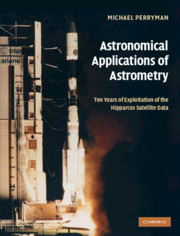Book contents
- Frontmatter
- Contents
- Preface
- 1 The Hipparcos and Tycho Catalogues
- 2 Derived catalogues and applications
- 3 Double and multiple stars
- 4 Photometry and variability
- 5 Luminosity calibration and distance scale
- 6 Open clusters, groups and associations
- 7 Stellar structure and evolution
- 8 Specific stellar types and the ISM
- 9 Structure of the Galaxy
- 10 Solar System and exoplanets
- Appendix A Numerical quantities
- Appendix B Acronyms
- Appendix C Author gallery
- Index of first authors
- Subject index
10 - Solar System and exoplanets
Published online by Cambridge University Press: 23 November 2009
- Frontmatter
- Contents
- Preface
- 1 The Hipparcos and Tycho Catalogues
- 2 Derived catalogues and applications
- 3 Double and multiple stars
- 4 Photometry and variability
- 5 Luminosity calibration and distance scale
- 6 Open clusters, groups and associations
- 7 Stellar structure and evolution
- 8 Specific stellar types and the ISM
- 9 Structure of the Galaxy
- 10 Solar System and exoplanets
- Appendix A Numerical quantities
- Appendix B Acronyms
- Appendix C Author gallery
- Index of first authors
- Subject index
Summary
This chapter covers the use of the Hipparcos data in two loosely connected areas: observations and interpretation related to the Solar System, and observations related to exoplanets.
Hipparcos Solar System objects
Astrometric and photometric measurements of a number of Solar System objects were performed either by the Hipparcos main instrument (and thus appear as the Hipparcos Catalogue Solar System Annex) or by the star mapper instrument (and thus appear in the Tycho Catalogue Solar System Annex). A summary is provided in Table 10.1. The results concern mainly asteroids, but also the planetary satellites Europa, Ganymede, Callisto, Titan and Iapetus, and the major planets Uranus and Neptune. Reductions were accurate to the mas level for the main mission. A detailed description of the resulting catalogue contents is given in ESA (1997), Volume 1, Section 2.7. Volume 3, Chapter 15 gives details of the specific data analysis aspects. Hestroffer et al. (1998a) also summarised the measurements and reductions relevant for Solar System objects, the objects observed, and the presentation of results.
There were two main objectives for the inclusion of Solar System objects within the observing programme. The first was to establish the relationship between the resulting dynamical reference system and the stellar reference frame (ICRF). To date, the theoretical positional precision of asteroids had never been met observationally, and they only entered into the FK5 solution, for example, with relatively modest weight. The second objective was to acquire improved positional data at a series of epochs to enable dynamical and physical studies of these objects. In the case of high-accuracy astrometry of very close encounters, for example, masses of some asteroids can be obtained.
- Type
- Chapter
- Information
- Astronomical Applications of AstrometryTen Years of Exploitation of the Hipparcos Satellite Data, pp. 566 - 618Publisher: Cambridge University PressPrint publication year: 2008

